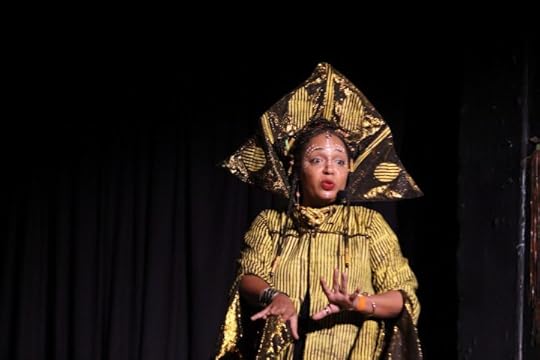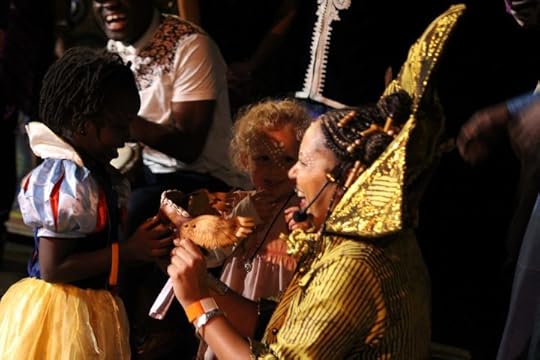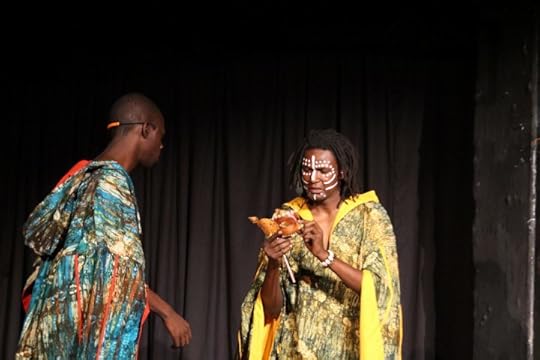Ruffling feathers and the power of telling our own stories

Ma��mouna Jallow's The Door of No Return. Image credit Mohammed Gure.
In November 2018, the South African fast food chain Chicken��Licken��launched a new ad campaign.�����A long long time ago, when leather was still in fashion, a young man left his home to satisfy his hunger for adventure����������begins the��opening��line of the ���Legend of Big John.�����It��tells��the��story of��an African man who in the 17th��century discovers a foreign land and names it Europe. A��month��after its release, the ad��was��banned by��the South African Advertising��Regulatory Board��who��ruled that colonization is ���not open for humorous exploitation��� and that the ad ���trivializes��an issue that is triggering and upsetting for many South African people.��� If you haven���t seen the ad,��watch it now before continuing.
I find it not only hilarious, but also subversive.��I especially like the��part where the white woman at the end gives��Big��Mjohnana, the young man of the legend,��the eye.��Perhaps that is what did it for the regulators.��We all know that white men have always been sensitive about�����the black��mandingo.���
I fully agree with commentator��Zama��Mdoda��when he writes:
The ad didn���t seek to make light of colonization or the trauma it inflicted (and still inflicts). If anything, it depicts an unrepresented version of the African, one with agency and adventure compared to the unwilling victims of a colossal system of exploitation. It���s also tea-worthy commentary on the absurdity found in the notion that a person can discover a land with people already living there, which I consider a hearty fuck you to Christopher Columbus.
When we as Africans��tell our own stories, we��re-write the stories in the history books that our children are still taught in schools. We��do what Edward Said wrote��about decades ago in his seminal work,��Orientalism, and move from being��objects��to becoming��subjects��of our stories.��And��when it comes in the form of “reimagined” legends, folktales and myths, as this ad has done,��we reclaim some��of that history.
Last year, I edited an anthology of Re-Imagined��Folktales from Africa��entitled��Story Story, Story Come. The collection of 12 tales by writers from eight African countries seeks to do what��Grant de Sousa,��the director of the Chicken��Licken��ad,��has done��with the Legend of Big John���tell stories from an African perspective.��Speaking at the launch of the ad,��De Sousa��said,�����The beginning of my treatment was this painting which we had all seen in textbooks here. It was this insane depiction of these glorified��Europeans, namely the Dutch, rocking up on the shores of South Africa, and ‘rescuing’ these poor African villagers.���
 Kids with Ma��mouna. Image credit Mohammed Gure.
Kids with Ma��mouna. Image credit Mohammed Gure.In��Story Story, Story Come, one author uses the site of��real archeological carvings of giraffes in Niger as the inspiration for her story in which a little girl imagines how they got there and whether they will still be there for generations to come as we continue to destroy our planet. In another tale from Zambia, a young blind girl called��Ikete��i��restores the blind King���s eyesight through her bravery, subverting the idea that young girls and people living with disability cannot be heroes in stories��and in real life. One of my��favorite��characters is��Ma���Dlovu, who��saves her community from starvation with the help of a talking mushroom (which��also��happens to be a reincarnation of Thomas��Sankara), and in the��process��leaves her useless drunkard of a husband who hangs��out��with people who�����buy him drinks but do��nothing to help him succeed.�����We all know people like that!
Some of the stories tackle themes recurrent in traditional folktales, such as greed. For example, we find out��Why Chickens Cannot Fly. It is because Chicken,��after being named King of the Skies because his comb resembles a crown, squanders all the birds��� wealth on gold and��many wives, and is condemned to a lifetime on the ground. Others, notably��The Big��Nest��from South Sudan is a��powerful tale about how war destroys families and the very��glue that keeps communities together.��What they all have in common is that they speak to issues that��we face today as Africans.��Without censorship.
 John Titi and Nguz in The Door of No Return. Image credit Mohammed Gure.
John Titi and Nguz in The Door of No Return. Image credit Mohammed Gure.The ban of the Chicken��Licken��ad is testament to the fact that we need to control our��means��of production and distribution.��The publishers of the anthology,��Zukiswa��Wanner��and Lola��Shoneyin��are African women. The illustrator, lay-out designer, and I, the editor, are all African women.��Who is telling the story, who is editing it, who is turning words into images, and who is publishing it matters just as much as the��story��itself. And I am proud to say that the��Story Story, Story Come��anthology is��truly ours.
To buy a copy of��Story Story, Story Come: For more information about the Re-Imagined Folktales Project, click��here.
Sean Jacobs's Blog
- Sean Jacobs's profile
- 4 followers



